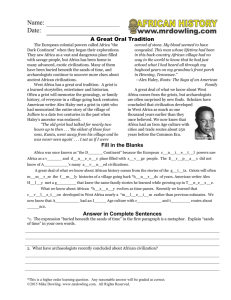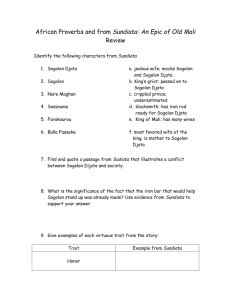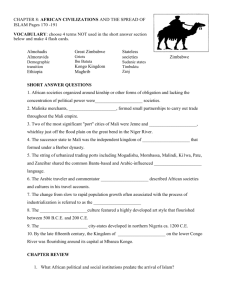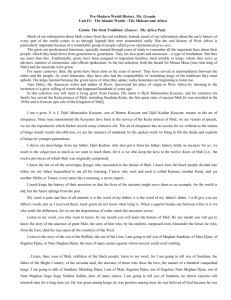The Oral Traditions of Africa
advertisement
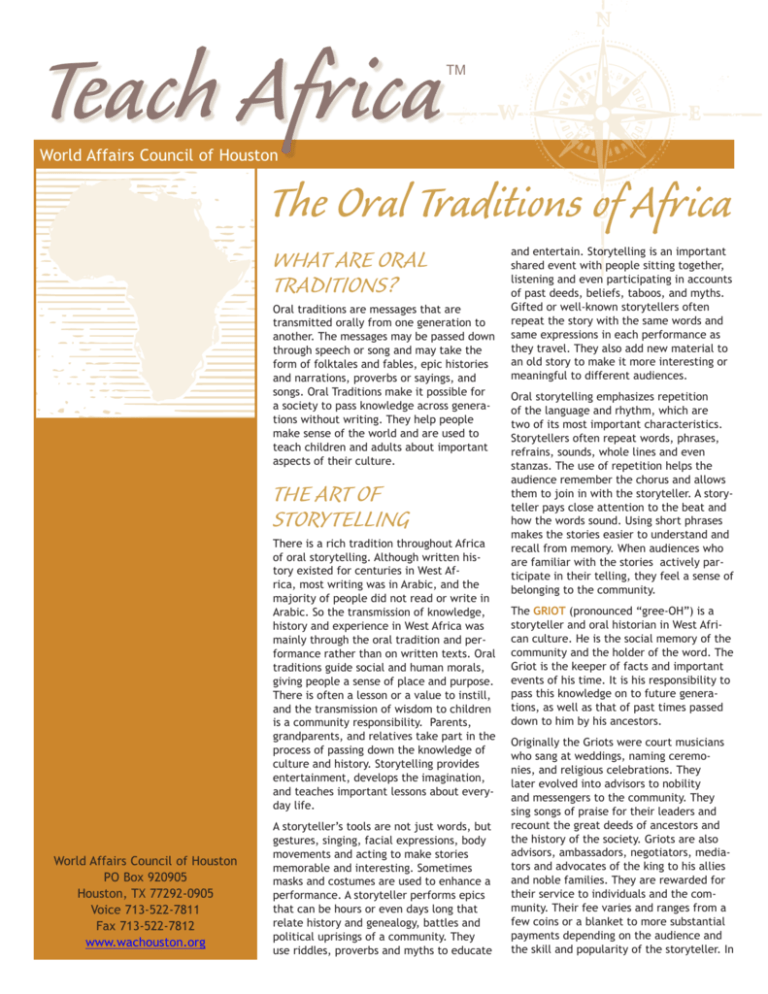
Teach Africa tm World Affairs Council of Houston The Oral Traditions of Africa What are oral traditions? Oral traditions are messages that are transmitted orally from one generation to another. The messages may be passed down through speech or song and may take the form of folktales and fables, epic histories and narrations, proverbs or sayings, and songs. Oral Traditions make it possible for a society to pass knowledge across generations without writing. They help people make sense of the world and are used to teach children and adults about important aspects of their culture. The art of storytelling There is a rich tradition throughout Africa of oral storytelling. Although written history existed for centuries in West Africa, most writing was in Arabic, and the majority of people did not read or write in Arabic. So the transmission of knowledge, history and experience in West Africa was mainly through the oral tradition and performance rather than on written texts. Oral traditions guide social and human morals, giving people a sense of place and purpose. There is often a lesson or a value to instill, and the transmission of wisdom to children is a community responsibility. Parents, grandparents, and relatives take part in the process of passing down the knowledge of culture and history. Storytelling provides entertainment, develops the imagination, and teaches important lessons about everyday life. World Affairs Council of Houston PO Box 920905 Houston, TX 77292-0905 Voice 713-522-7811 Fax 713-522-7812 www.wachouston.org A storyteller’s tools are not just words, but gestures, singing, facial expressions, body movements and acting to make stories memorable and interesting. Sometimes masks and costumes are used to enhance a performance. A storyteller performs epics that can be hours or even days long that relate history and genealogy, battles and political uprisings of a community. They use riddles, proverbs and myths to educate and entertain. Storytelling is an important shared event with people sitting together, listening and even participating in accounts of past deeds, beliefs, taboos, and myths. Gifted or well-known storytellers often repeat the story with the same words and same expressions in each performance as they travel. They also add new material to an old story to make it more interesting or meaningful to different audiences. Oral storytelling emphasizes repetition of the language and rhythm, which are two of its most important characteristics. Storytellers often repeat words, phrases, refrains, sounds, whole lines and even stanzas. The use of repetition helps the audience remember the chorus and allows them to join in with the storyteller. A storyteller pays close attention to the beat and how the words sound. Using short phrases makes the stories easier to understand and recall from memory. When audiences who are familiar with the stories actively participate in their telling, they feel a sense of belonging to the community. The Griot (pronounced “gree-OH”) is a storyteller and oral historian in West African culture. He is the social memory of the community and the holder of the word. The Griot is the keeper of facts and important events of his time. It is his responsibility to pass this knowledge on to future generations, as well as that of past times passed down to him by his ancestors. Originally the Griots were court musicians who sang at weddings, naming ceremonies, and religious celebrations. They later evolved into advisors to nobility and messengers to the community. They sing songs of praise for their leaders and recount the great deeds of ancestors and the history of the society. Griots are also advisors, ambassadors, negotiators, mediators and advocates of the king to his allies and noble families. They are rewarded for their service to individuals and the community. Their fee varies and ranges from a few coins or a blanket to more substantial payments depending on the audience and the skill and popularity of the storyteller. In West Africa, Griots have been practicing their craft for hundreds of years. Griots are described as “the all-seeing, all-knowing eyes of society.” There is a spiritual and ethical dimension to their performances and it is believed that special forces are released through the spoken or musical part of their performance. The Griotte (pronounced “gree-UT”) is a female storyteller. She traditionally sings at ceremonies, celebrations, and special occasions. When a woman is married, a Griotte will sing to her to prepare her for her new life. West African women sing about a women’s role in the society and their relationships with husbands and in-laws. Griottes also use songs to express their independence and self-reliance or to give comfort, encouragement, and empowerment to other women. The saabi is a long poetic narrative form sung by West African women to reveal the nature of relationships between men and women. ORAL HISTORY is a form of West African oral tradition. It is the recording, preservation and interpretation of historical information, based on the storyteller’s personal experiences and opinions. It often takes the form of eye-witness account about past events, but can include folklore, myths, songs and stories passed down over the years by word of mouth. WEST ARFRICAN FABLES & FOLKTALES are full of wisdom and generally convey a moral or teach a lesson. Often these lessons are ones of resourcefulness, independence, and illustrate the rewards of courage. There are different types of folktales, with fables and talking beasts’ stories among the most common. African proverbs can convey wisdom, truth, a discovery of ideas, as well as life lessons. epic narrations are the exploits of a hero who really existed and who played a major role in a people’s history. Their adventures may have been exaggerated to have greater impact. Genealogies are the detailed histories of a dynasty or a people. Epic stories and genealogies are often sung by Griots with a musical instrument. They can be very detailed and specific, providing historians with numbers, dates, and important names. Songs occupy an important place in African oral literature. Songs are present in all moments of life, especially on occasion of ritual ceremonies. THE GRIOT Griots are historians, praise-singers and musical entertainers. They are the guardians of the knowledge of their people’s ancestry and genealogy. As history may never be written down, the Griot is crucial to keeping records of the past. Griots are entrusted with the memorization, recitation, and passing on of cultural traditions from one generation to the next. The A West African Griot with his Kora Griot is called upon at important events, during which he recounts a family’s genealogy playing his Kora, or other musical instruments, such as the Ballafon. During these ceremonies, the youngest Griot acquires new knowledge. Griots as teachers and advisors In the time of Emperor Sundiata, Griots tutored princes and gave council to kings. They were educated and wise, and they used their detailed knowledge of history to shed light on present-day dilemmas. Long after the fall of the Malian Empire in 1468, a West African family of means would have their own Griot to advise them and help them negotiate matters with other families. Griots arranged the terms of marriages and mediated disputes, always Storytellers always have messages to relying on their unpass on at the time of celebrations derstanding of each family’s history. Griots as storytellers After a good evening meal, with the moon shining down, the people of a village in ancient Africa might hear the sound of a drum, a rattle, and a voice that shouted, “Come hear, come hear!” These were the sounds of the Griot. Under the rule of Sundiata’s grandnephew, Mansa Musa, Mali rose to its height. The Mali Empire comprised most of present-day Northern Guinea and Southern Mali. When they heard the call, the children knew they were going to hear a wonderful story, with music and dancing and song! Perhaps tonight the story would be about Anansi, the little spider! Everyone loved Anansi. Anansi could weave the most beautiful webs. He was the one who taught the people of Ghana how to weave the beautiful Mud Cloth. Anansi had a good wife, strong sons, and many friends. He got into many a mess, and used his wits and the power of humor to escape. page 2 There were other stories the people loved to hear over and over. Some stories were about the history of the tribe. Some were about great wars and battles. Some were about everyday life. Leopard obeyed. At first he was very successful and obtained all the food he wanted. One day, however, he was unable to catch anything at all. There was usually only one storyteller per village. If one village attempted to steal a storyteller from another village, it was cause for war. The Griots were not the only people who could tell a story. Anyone could shout, “Come hear, come hear!” But the Griots were the “official” storytellers. The village Griot did not have to work the fields; their job was to tell stories well. Being very hungry, he wondered what he could have for dinner. Suddenly he remembered that the cat had quite a large family. He went straight to her home and found her absent. A thousand years later, new stories about new triumphs and new adventures are still being told by the village Griots! They continue to play an important role in modern West African societies, but the Griot’s position in African society has changed. These performers are still in great demand to conduct ceremonies and parties, but today they also are popular singers who reinterpret traditional songs and perform on television and radio and record CDs. Griots are often the narrators in African film and explain or comment on the action or set the stage for the tale being told. Despite the changes in their duties, they continue to be respected members of the West African culture and provide a strong link to the past. They continue to be the historians, genealogists, advisers to nobility, entertainers, messengers, and praise singers in communities. Never thinking of her kindness to him, Leopard only remembered that he was hungry, and he ate all her kittens. When Cat discovered this dreadful act, she was so angry that she refused to have anything more to do with the great creature. Consequently, Leopard has never been able to learn how to catch animals that pass him on the right side. WEST AFRICAN FABLES & FOLKTALES WHY THE LEOPARD CAN ONLY CATCH PREY ON ITS LEFT SIDE Once upon a time, Leopards did not know how to catch animals for food. Knowing that the Cat was very skilful in this way, Leopard one day went to Cat and asked very politely if she would teach him the art. Cat readily consented. The first thing Leopard had to learn was to hide himself among the bushes by the roadside, so that he would not be seen by any animal passing by. Next, he had to learn how to move silently through the woods. He must never allow the animal he was hunting to know that he was following it. The third great principle Cat taught Leopard was how to use his left paws and left side in springing upon his prey. Having taught him these three things, Cat asked Leopard to go and practice them well. When he had learnt them thoroughly he could return to her and she would give him more lessons in hunting. A Sea Turtle Why Turtles Live In Water Turtles used to live on the land, they say, until the time a clever turtle was caught by some hunters. They brought him to their village and placed the turtle before the Chief, who said, “How shall we cook him?” “You’ll have to kill me first,” said the turtle, “and take me out of this shell.” “We’ll break your shell with sticks,” they said. “That’ll never work,” said the turtle, “Why don’t you throw me in the water and drown me?!” “Excellent idea,” said the Chief. They took the turtle to the river and threw him into the water to drown him. They were congratulating themselves on their success in drowning the turtle, when two little green eyes poked up in the water and the laughing turtle said, “Don’t get those cooking pots out too fast, foolish people!” As he swam away he said, “I think I’ll spend most of my time from now on, safely in the water.” It has been that way ever since! A Leopard Catching Prey on Its Left Side page 3 proverbs Lyrics of the song “Moving Away” by Kasse Mady Diabate, a griot from Mali Proverbs are an illustration of a vivid and fundamental truth • It takes a village to raise a child. • When a king has good counselors, his reign is peaceful. • No matter how long the night, the day is sure to come. • One falsehood spoils a thousand truths. • Do not call the forest that shelters you a jungle. • When you follow in the path of your father, you learn to walk like him. • It is best to bind up the finger before it is cut. • The fool speaks, the wise man listens. • Do not say the first thing that comes to your mind. • A little rain each day will fill the rivers to overflowing. • Cross the river in a crowd and the crocodile won’t eat you. • Not to know is bad; not to wish to know is worse. • Do not follow the path. Go where there is no path to begin a trail. “People listen to me, black people, white people, Africans, Europeans, children and adults, listen to what I am saying! “What I’m saying is for the young people to hear us, to know that the Kings and Emperors who passed away before us did well. “They were just human beings, but they worked hard and did well so we should be doing the same. “Let’s be proud of ourselves, get to know yourself and you will get to know someone else. “Oh world, all the world, Africans and Europeans, let’s be together. “This is the best thing that could happen. Let’s help each other, this is the only way we can succeed.” Kasse Mady’s lyrics rally people together, to persuade them to live harmoniously with each other. “Sundiata: An Epic of Old Mali” by D. T. Niane Malian Oral Historians, the Griots, have traditionally retold stories of ancient Kings and Emperors of Old Mali. One popular story that is frequently recounted to this day is the Epic of Sundiata, the founder of the Mali Empire. Recorded in a book by a West African historian, D T Niane, the “semi-historical” biography of Sundiata Keita, entitled Sundiata: An Epic of Old Mali tells Sundiata’s story as recounted by the Griot Djeli Mamadou Kouyaté. Sundiata, who was the weak child of King Maghan by his second wife, had been taken into exile at a young age by his mother, the Buffalo woman. During that time, the sorcerer king, Suomaoro Kanté of the Sosso, had conquered Mali, and took Sundiata’s sister and his Griot as captives. This made war between the two inevitable. Sundiata, upon hearing of what had become of his nation, decided to go back to Mali to free his people Sundiata: The Lion King of Mali and claim his throne and Griot. In doing so, Sundiata manages to gather fighters, unite the twelve kingdoms, and build the Mali Empire. Sundiata’s epic story has been told for centuries through the eyes of his very own Griot Balla Fasséké. discussion questions • Why are oral traditions so important? • What do oral traditions say about African society? • What role do oral traditions play in African culture? What role do oral traditions play in our culture? • Why would it be important for a Griot to have a long and accurate memory? • Why are stories and tales important? • Compare African and Western Civilization fables you have studied. What are the notable differences/similarities you can notice? • African tales were designed to teach and entertain. What fills that role in our society? • How many generations back do your family stories reach? • What is your favorite African proverb? Does it remind you of a Western proverb? • Create your own proverb based on examples of African proverbs. page 4
